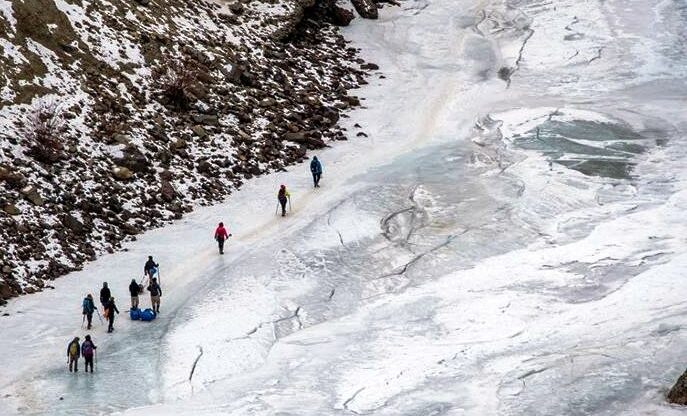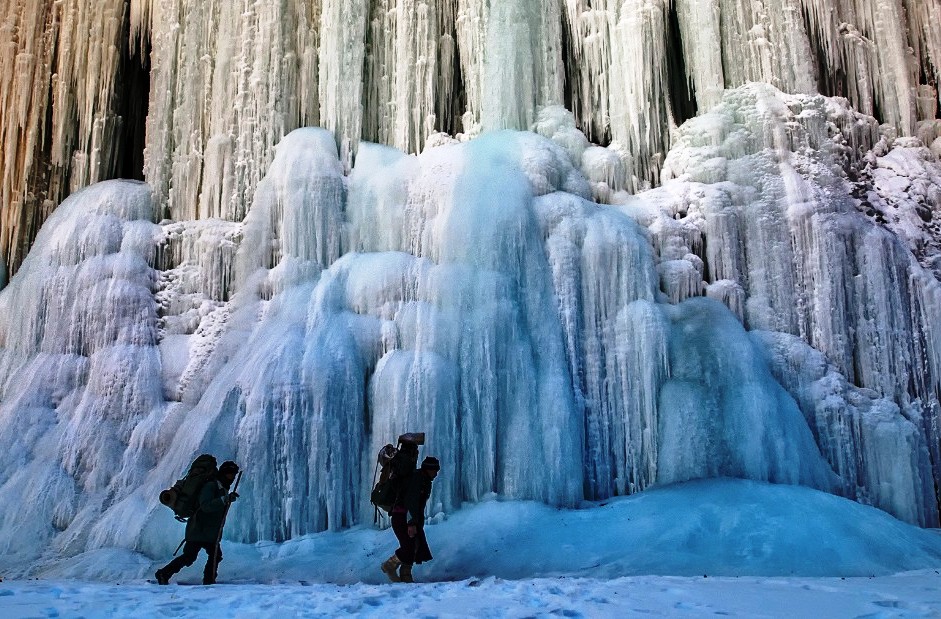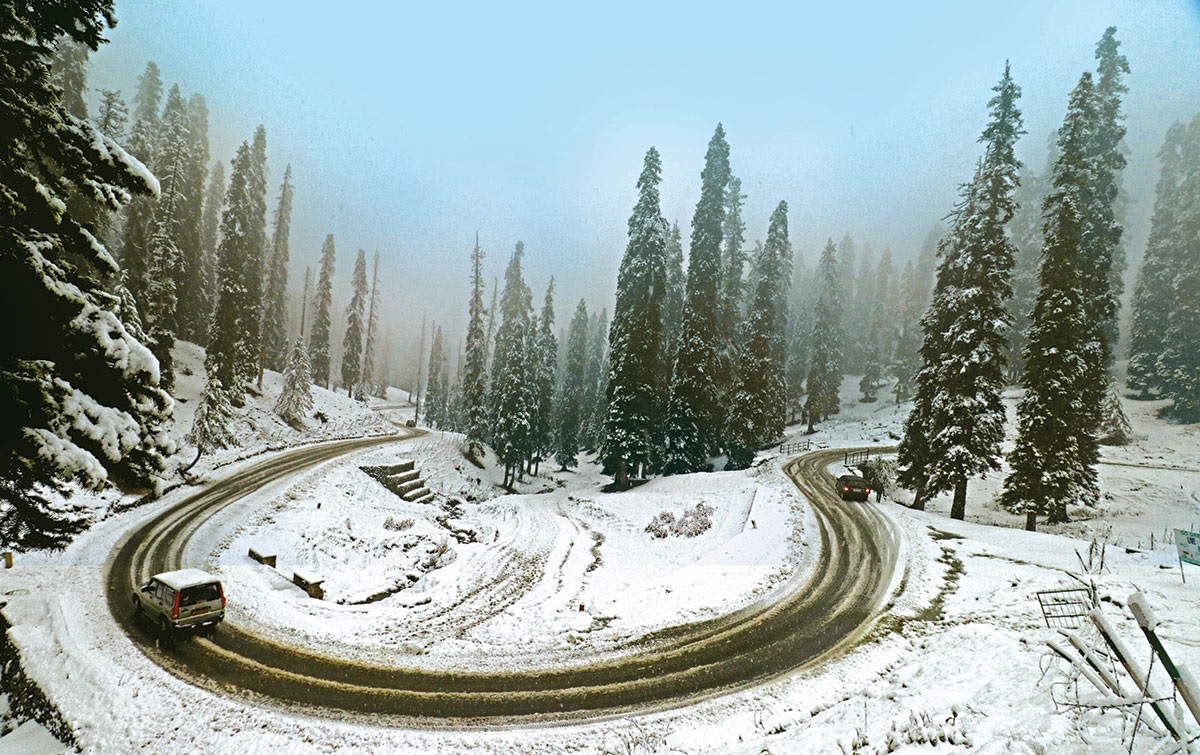Dictated by crippling inaccessibility during winter, residents in Zanskar used to travel in groups over the frozen river and reach Kargil and Leh. With the passage of this arduous journey became the challenging and entertaining Chander Trek that now attracts hundreds of tourists during the peak desert winter, reports Babra Wani

The Chadar Trek in Ladakh is an adventurous winter trek that has gained immense popularity over the last decade. Chadar refers to the sheet of ice that gets formed on the surface of the Zanskar River during winter and when tourists use it as a road, it becomes the Chadar Trek.
The Chadar Trek involves walking for 6-7 days on the frozen Zanskar River to reach villages deep inside the Zanskar valley that get cut off from the rest of the world during peak winter.
The Chadar trek starts from Chilling village, about 65 km from Leh on the Leh-Srinagar highway. Trekkers must reach Leh first and acclimatise for a day before starting the Chadar trek. From Chilling, the trek involves walking on the frozen Zanskar river to reach various campsites like Tilat Sumdo, Shingra Koma, Tibb, and finally Nerak village. The return journey follows the same route back to Chilling village from where trekkers are picked up and brought back to Leh. The total Chadar trek distance is about 75 km and is covered in over 6-7 days.

The months of January and February are the best time to undertake the Chadar trek when the ice sheet on the Zanskar River is at its thickest. The temperature during these months drops to as low as -35 degrees Celsius at night. The day temperature hovers around -15 to -20 degrees Celsius. The Chadar forms in December but it takes a few weeks for the ice sheet to become thick enough to support humans walking over it.
By March, the Chadar starts melting making the walk too risky. In 2018, when a group of eight residents used the trek to reach Leh, they had to be rescued as the ice sheets gave in under their weight.
The Chadar trek difficulty level is ‘moderate to difficult’ and requires good physical fitness. Trek participants need strong lungs to adapt to high altitudes (11,000+ feet) and good mental strength to endure extreme cold temperatures. Though it is non-technical, the icy cold unpredictable terrain makes it tougher. Participants should have some prior high-altitude trekking experience. Proper layering of clothing and following other precautions are musts to complete the Chadar trek.
The Chadar route starts from Chilling village which has a few homestays for trekkers to spend a night before embarking on the trek on the iced Zanskar river the next morning. After about an hour’s walk from Chilling, the first campsite Tilat Sumdo comes. It is located at the confluence of a tributary that joins the Zanskar River from the left. Tilat Sumdo campsite has enough space for setting up multiple tents.
After Tilat Sumdo, the trail continues along the Chadar to reach Shingra Koma after 6-7 hours. Shingra Koma derives its name from a locally available medicinal herb. The campsite has a huge rocky mountain wall rising straight from the opposite bank of the river presenting a dramatic setting.
From Shingra Koma starts the most stunning stretch of the Chadar trek leading to the next campsite Tibb. This section has massive frozen waterfalls, hanging ice stalactites, narrow gorges, and different shades of blue ice. Tibb has many natural caves along the river that serve as an alternate accommodation option.
The last campsite on the Chadar trek is Nerak village which has only one permanent hut that acts as shelter for the Chadar trekkers and rafters during summers. Nerak is situated about 2000 feet above the Zanskar river bed. Participants need to trek uphill for around 200 feet to reach the Nerak campsite. It offers dramatic views of the frozen river down below and the valley. After spending a night here, the return journey to Chilling village starts which follows the same trail back.
Trek Highlights
Frozen Waterfall: One of the major highlights of the Chadar trek is a magnificent frozen waterfall route at Tibb campsite whose origin as per legend lies at Mount Kailash in Tibet. It cascades down into the Zanskar Gorge not very far from the Nerak village.

The Chadar: The Chadar itself, which refers to the sheet of translucent blue ice formed over the river, is the highlight of the trek. Its appearance, texture and properties seem magical as the structure constantly changes with the weather.
Nerak Village: Nerak is the farthest point of the Chadar trek. Participants not only get to camp overnight in this quaint remote village but also get to interact with the locals and understand their winter survival.
Treacherous Sections: The Chadar does not form evenly across the river. Some sections pose serious challenges with either very thin ice coverage or no Chadar at all. Trek participants find it adventurous to negotiate across such sections.
Caves: Enroute Tibb and near Nerak are numerous natural caves created by the river where participants can sleep instead of tents. It adds to the thrilling experience.
Logistics
To reach Leh in winter, the only option is by flight as roads are closed. It is crucial to stay overnight in Leh for acclimatisation before starting the trek. Participants must have proper winter clothing, trekking gear, waterproof shoes, and gear suitable for -40 degrees Celsius temperatures. Certified guides, local support staff, and porters are provided for safety, including setting up ropes and bridges over icy patches.
Since the trek has no steep inclines or declines, participants carry daypacks, while other luggage is carried by ponies. Good cardiovascular fitness and strength training are essential for this challenging trek. Acclimatisation in Leh before the trek helps prevent Acute Mountain Sickness (AMS). The cost of a 6-day Chadar trek ranges from Rs 15,000 to Rs 30,000, covering guide fees, camping supplies, meals, porters, and mule charges. Flights and accommodation in Leh are not included.
The trek fee usually includes shared tents, sleeping bags, meals, porter charges, basic first aid, and Leh airport transportation. Personal expenses in Leh, emergency costs, and transportation to/from the trek start point are not covered. Tour organisers have varying refund policies for cancellations, offering options like transferring bookings, rebooking, or receiving vouchers during peak seasons.
The Chadar Trek is thus a unique adventurous winter trek undertaken by walking on the frozen river in extreme conditions. With a reasonable fitness level and guidance from expert trek leaders, it can be an experience of a lifetime. It takes considerable mental resilience to conquer one’s fears and face nature’s difficulties. The rewards of completing such an audacious trek in the form of everlasting memories and a sense of achievement stay forever. With responsible eco-tourism, the Chadar trek’s raw untouched natural beauty can be preserved for future generations.
In February 2018, a Pune trekker was killed during the trek because he had started the arduous travel without getting acclimatised. A local girl in the same year slipped into the ice-cold river and died instantly.
People in Zanskar have historically used the trek to access Leh and Kargil during winter. They usually move in groups and are well-prepared. Gradually this emerged as a sport and a tourist attraction. The river is closed for any treks in the middle of February.
















A wonderful description indeed.
I have written a complete travelogue / Book on the Chadar Trek by the name of
“Walking on the Frozen River” is available on Amazon.
It will be a good read for enthusiasts and travelers.